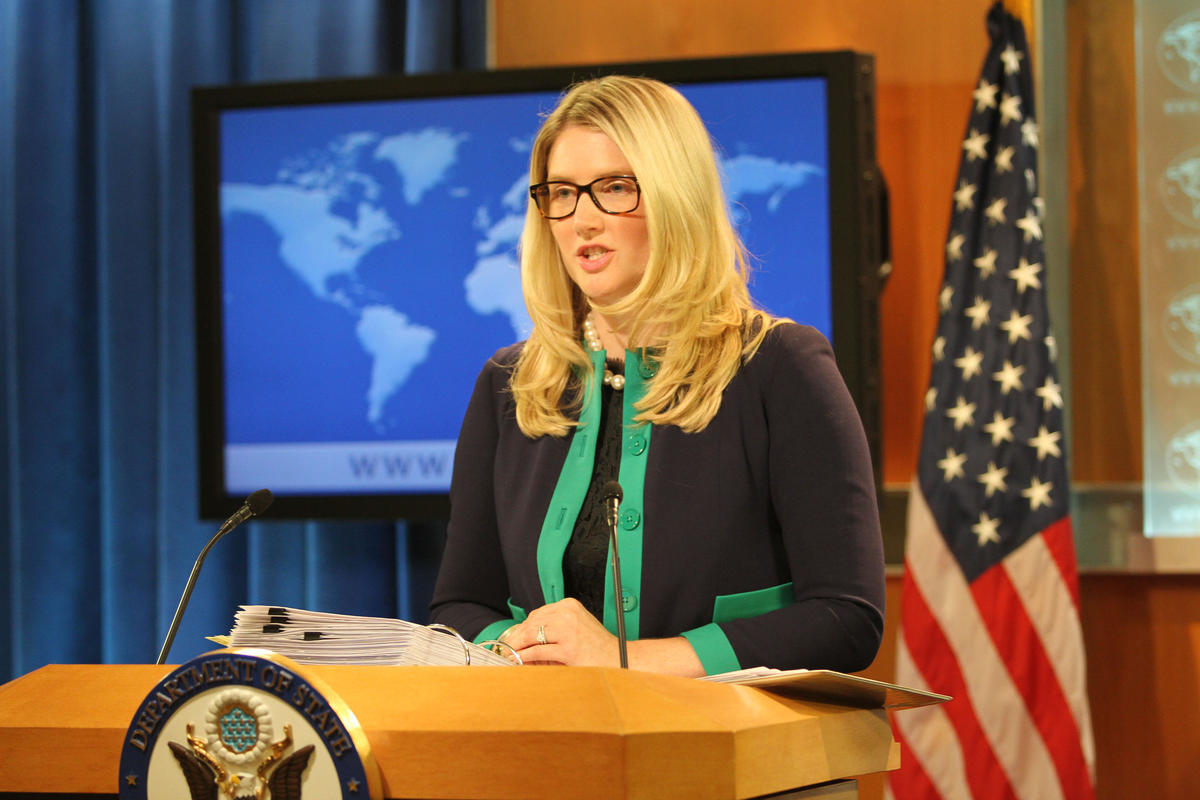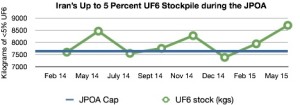by Derek Davison
On Tuesday, The New York Times published what appeared at first to be a troubling update on the state of Iran’s nuclear program. In a piece headlined “Iran’s Nuclear Stockpile Grows, Complicating Negotiations,” the paper’s chief Washington correspondent David E. Sanger and science reporter William J. Broad discuss a May 29 report from the International Atomic Energy Agency (IAEA) on Iran’s compliance with the Nuclear Non-Proliferation Treaty and relevant UN Security Council resolutions.
The IAEA found no evidence that Iran has made any illicit progress toward building a nuclear weapon, Sanger and Broad write. But the IAEA report, they add, did suggest that Iran has not adhered to its obligations with respect to the size and nature of its stockpile of low enriched (less than 5% enrichment) uranium hexafluoride gas (UF6), the form in which the uranium can be fed into centrifuges and further enriched, theoretically to weapons-grade (over 90% enrichment). This stockpile is to be capped at 7650 kilograms under the terms of the Joint Plan of Action (JPOA), which went into effect in January 2014 and has governed the negotiations since then. Iran is required to convert any UF6 that is “newly enriched” while the JPOA is active to uranium oxide powder (UO2), which cannot be fed into centrifuges.
However, according to the IAEA report, Iran’s UF6 stockpile has increased to its current amount of 8714.7 kilos, a development that, according to Sanger and Broad, is “undercutting the Obama administration’s contention that the Iranian program had been ‘frozen’” since the implementation of the JPOA. They argue that the IAEA report “poses a major diplomatic and political challenge for President Obama and Secretary of State John Kerry” as they try to secure a final agreement. It calls into question whether Iran will or even can meet its obligations under the JPOA and under a future comprehensive plan, where it will likely have to limit its enriched uranium stocks to somewhere in the 300 kilogram range.
Story Debunked
The problem for the Times reporters is that most experts in either arms control in general or the Iran negotiations in particular disagree with their bleak assessment of the IAEA report. State Department spokesperson Marie Harf used her daily briefing to sharply criticize Sanger and Broad’s story, saying that “the main contentions of it are just totally inaccurate” and adding that Iran’s LEU stockpiles are allowed to fluctuate under the terms of JPOA “as long as at the end of a fixed date [at this point June 30] they are back down below a number [7650 kilograms].” In other words, the JPOA permits Iran’s continued production of LEU, and the Obama administration has never claimed otherwise. So it’s not clear why the IAEA’s report would “undercut” the administration’s position.
Harf also directly challenged Sanger over his reporting via Twitter, in a series of remarkably frank messages in which she called several of the Times piece’s assertions “not true,” including its contention that the IAEA report “poses a major diplomatic and political challenge” to the US and its implication that Iran is “in violation of its obligations” under the JPOA.
Mark Fitzpatrick, director of the Non-Proliferation and Disarmament Program at the International Institute for Strategic Studies, also tweeted on Tuesday that “Growth in Iran’s LEU stockpile is a non-issue, as long as excess is fed into oxide conversion by 30 June.”
Far more seriously for Sanger and Broad, the one expert they did quote in their piece is arguing that the Times reporters took his quote out of context:
“From the U.S. perspective, it’s obviously less than ideal,” said Richard M. Nephew, an Iran specialist at Columbia University, who worked at the White House and State Department. Mr. Nephew said the enlarged stockpile was not a deal breaker because Iran could find a way of solving the problem, especially if it was offered sanctions relief.
On Wednesday, Nephew took to Twitter to say that the full version of the quote he gave to Sanger and Broad was “from the U.S. perspective, it’s obviously less than ideal, but we’ve managed for the last 18 months, so I don’t see it as a huge deal, again barring a last-minute technical glitch.” The full quote gives a much different impression of Nephew’s thoughts than the truncated version offered by the Times.
Fuller Explanation
I contacted Nephew by email to ask if he felt misrepresented by Sanger and Broad, and whether he had been in contact with them since the article’s publication. “I did reach out,” he told me, “and Mr. Broad said that they had to do the normal journalistic practice of shortening and tightening to tell a story with brevity and so forth. He was surprised I felt misrepresented. I acknowledged that journalists do need to be able to tell a concise story, but I noted that I did feel misrepresented and asked that they update the piece with my quote in full, as well as with the broader content that I articulated to them. [I’ve received] no response thus far.”
Additionally, Nephew pointed out that when he spoke to Sanger and Broad of “sanctions relief,” it was in reference to Iran’s incentives to reduce its enriched uranium stockpile in order to meet the terms of a comprehensive agreement, not in the context of addressing the current excess uranium issue that was at the crux of the Times piece. That distinction seems to have been lost in Sanger and Broad’s reporting.
Nephew, who is also a non-resident senior fellow at the Brookings Institution, published his own response to the uranium story on Brookings’ “Markaz” blog on Wednesday. He argued—without referring specifically to the Times report—that the crux of Sanger and Broad’s analysis “is lacking in several important respects.” As Nephew explained, the administration has been well aware that Iran continues to produce UF6 and that it has experienced a number of technical problems in implementing its oxide conversion plans. He emphasized that fluctuations in Iran’s stockpile are perfectly normal and that, in fact, over the life of the JPOA Iran has frequently held more than 7650 kilos of UF6. But it has also managed to bring its stockpile below that figure in advance of every deadline it has had to meet during the negotiating process:
Graph created by Richard Nephew (source)
Alarmist Bias at The Times
Tuesday’s Times report adds to a body of work by the paper, and Sanger in particular, that has shown a consistently alarmist, anti-Iran bias for several years, a pattern that has been highlighted by LobeLog on multiple occasions:
- LobeLog contributor Ali Gharib wrote last month about a Times piece in which Sanger reported that Saudi Arabia will “match Iran in nuclear capability,” as though this were in itself an objection to a nuclear deal with Iran. Yet Ali was able to cite several expert analysts who argued that the Saudi adoption of a nuclear program under the same terms that are being negotiated with Iran would actually be a good thing from a non-proliferation standpoint.
- In March, LobeLog’s Robert Kelley (a nuclear engineer and expert in nuclear weapons development and non-proliferation issues) heavily criticized a Sanger and Broad-authored piece that made several errors in its discussion of Iran’s supposed nuclear weaponization capabilities. These included an assertion that Iran possesses a “plutonium complex” that no analyst, including the IAEA, believes it has, and a claim that Iran has refused to answer IAEA questions that the IAEA itself says have been answered. Robert concluded that “political biases trumped technical accuracy” in the writing of the piece.
- All the way back in 2010, LobeLog contributor Daniel Luban reported on another Sanger alert, in this case over Iran’s supposed purchase of 20 long-range nuclear-capable missiles from North Korea. In this case, Sanger’s reporting eventually had to be walked back by the Times, though, as Daniel noted at the time, Sanger “had a byline on the first story [reporting the supposed missile sale] but not the second [the walk-back].”
Another instance of Sanger’s questionable reporting occurred last November, when he and Broad collaborated on a piece that warned of the possibility that Iran might covertly seek to develop a nuclear weapon. Obviously U.S. negotiators are concerned about this possibility. If they weren’t, then inspections and monitoring requirements would hardly be as critical an issue in the ongoing talks as they are. But in their alarmism, Sanger and Broad misrepresented the findings of the 2007 US National Intelligence Estimate that found that Iran had placed whatever weapons program it may have once had on hold in 2003. They wrote that the 2007 NIE “also concluded that smaller-scale activity continued, and warned that ‘Iran probably would use covert facilities—rather than its declared nuclear sites—for the production of highly enriched uranium for a weapon.’”
The latter point is accurate, but meaningless. Obviously Iran would prefer to use a covert facility for weapons development in the hypothetical scenario that it chose to build a weapon. But to the former point, the NIE actually concluded that Iran had been “continuing to develop a range of technical capabilities that could be applied to producing nuclear weapons,” like its uranium enrichment program and “research and development projects with commercial and conventional military applications—some of which would also be of limited use for nuclear weapons.” In other words, Sanger and Broad’s “smaller-scale activity” may have had nothing whatsoever to do with developing nuclear weapons, or weapons of any kind for that matter, but you wouldn’t have known that by their reporting.
It should concern anyone who values objective journalism that America’s “Newspaper of Record” has handed its Iran coverage to a reporter with a disturbing track record of bias, alarmism, and sloppy reporting. Sanger’s misquoting of Richard Nephew in Tuesday’s piece is a particularly egregious example of this phenomenon, but it is hardly the first and likely will not be the last.







I just returned from Washington. While there I visited the Arlington cemetery. All who propose wars should see the 160,000 marble slabs – then you give me your opinion about going to war with Iran to satisfy a favorite ally.